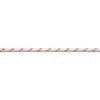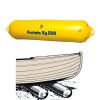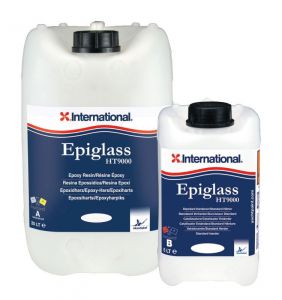-
x
Description
International Epiglass HT 9000 Epoxy Resin A+B Standard. Unit size 3.75 Lt.
PRODUCT DESCRIPTION
A versatile epoxy resin system, suitable for a wide variety of uses, such as laminating, filling and fairing, and gluing, on any type of boat. In addition to the high strength and durability associated with epoxy resins, this unique and easy-to-use formula offers many special features:
* Solvent free and low odour ensuring a cleaner working environment
* Improved workability to adapt to varying environments
* Low viscosity for ease of mixing and wet out
From a background of thirty years of experience in Australia and New Zealand, International now offers a tried and tested multipurpose epoxy system for professional and DIY use. The Epiglass HT9000 Standard system is certified for use in constructions built under Lloyd's Register survey.
PRODUCT INFORMATION
Colour YAA900-Clear
Finish Gloss
Specific Gravity 1.11
Volume Solids 100%
Mix Ratio 4:1 by volume
4.75:1 by weight
Converter/Curing Agent YAA904 - Standard Curing Agent
Typical Shelf Life 2 yrs
VOC (As Supplied) 0 g/lt
Unit Size 5 lt, 25 lt, 250 lt
DRYING/OVERCOATING INFORMATION
Drying
15°C (59°F) 25°C (77°F) 35°C (95°F)
Pot Life 50 mins 30 mins 20 mins
Note: Pot life reduces as temperature and mix volume increases. Thin Film Working Times: 15°C - 4 hrs; 25°C - 2 hrs; 35°C - 1 hr
Overcoating
Substrate Temperature
Note: Due to the variety of film builds, and hence different cure times, it is not possible to give specific overcoating times. Overcoating HT9000 with itself: HT9000 resin and/or HT9000 glue/filler mixes may be overcoated with themselves or each other whilst they are still wet or tacky. After this period, overcoating can be carried out whilst the mixes are green (i.e. soft to the fingernail). Once the products feel hard to a fingernail they should be washed down to remove any amine bloom and sanded well. Overcoating with other products:Overcoating HT9000 resin or HT9000 Filler/Glue mixes with any solvent containing paints should not be carried out until the surfaces can be sanded using 80-120 grit paper.
APPLICATION AND USE
Preparation GRP: Thoroughly abrade using 80-120 grade paper.Degrease with Thinners No. 7. Ensure surface is dry before application of the epoxy. New laminates must be at least one month old before application of Epiglass HT9000 Standard.
New laminates should also be cleaned first with Yacht Line Super Cleaner to remove mould release agents, silicones and grease.
WOOD: Moisture content of the wood should be below 12%. For higher moisture content the timber must be allowed to dry prior to application of Epiglass HT9000 Standard. Abrade with 80-120 grade (grit) paper. Sand across the grain with 40-60 grade paper for good adhesion when gluing. Wipe down with Thinners No. 7. Epoxy resin should not be used for structural work with oily timbers. For smaller repairs on oily timbers, abrade as per above recommendation and degrease with acetone. Allow solvent to evaporate.
METAL: To ensure a good physical 'key' on the surface, remove all surface contaminants by abrading, grit blasting or grinding to expose bright metal. Wipe down with Thinners No. 7. Apply the epoxy resin as soon as possible after surface has been prepared, to prevent de-oxidisation. For Aluminium/Bronze/Lead, better adhesion will be achieved by sanding the resin mix into the surface using wet or dry paper. Hard anodised aluminium alloy must be removed.
Method: Apply to a surface pre-primed with a thin layer of resin mix. Techniques will vary depending on the job in hand. Refer to the Epiglass Epoxy Resin Guide. For Coating and Sheathing, apply a first primer coat and then subsequent coats with a brush or roller. A glue brush can be used for Gluing or a spatula which can also be used for Fillet Bonding. Use a spreader for Filling and Fairing applications. When using Epiglass HT9000 Standard as a wood sealer, or even when sheathing wood, it is beneficial to saturate the wood with a 100% diluted resin mix. This will further improve adhesion.
Diluted layers must be fully cured prior to application of subsequent (unthinned) coats. A hot air gun or alternatively a hair dryer can be used to warm the epoxy and shorten its cure time, whilst promoting good penetration of most wood types without the need for solvent addition. Pot life reduces as temperature and mix volume increases Ultra violet light will break down the epoxy over time and the completed work should therefore be painted or varnished. A range of International primers, undercoats and finishes are compatible with Epiglass HT9000 Standard. Refer to the International Boat Painting Guide for an introduction on the products and their use.
Useful tips: Mixing: Always measure accurately by volume to the 4:1 ratio. Epiglass Dispensing Pumps are calibrated to supply the 4:1 mix ratio. First few strokes could supply aerated resin and have an irregular flow. Ensure correct volume is supplied through the pumps before mixing for use (i.e consistent flow of resin). Add curing agent to the base in a mixing pot and stir slowly for approximately 2 minutes. Use a clean plastic container (alternatively metal) when mixing Epiglass HT9000 Standard and mix small amounts at any one time, to prevent heat build-up. Pour the Epiglass mix into a flat roller tray to allow longer working time.
IMPORTANT: Avoid using a glass container due to the risk of heat build up. If the epoxy resin starts to exotherm (build up heat) the container should be moved outdoors. Avoid breathing the fumes. Carefully blend in any additive powders chosen until the desired consistency is achieved. Further details on additives and their use can be found in the Epiglass Epoxy Resin Guide. Mix only as much as you can use in the stated pot life.
Thinner YTA061 Thinner No.7
Cleaner YTA061 Thinner No.7
Curing: The total cure time varies depending on hardener used (fast, standard or slow), volume mixed, temperature and the shape of the mixing cup. The pot lives recorded in this datasheet are based on a 100g resin/hardener mix at 23°C.
Some Important Points: Do not apply below 10°C. Woods such as teak and iroko are rich in natural oils, and so not usually suited to overcoating except with specialist varnishes such as Perfection Plus or Schooner. An amine blush may form on the surface of the Epiglass HT9000 Standard as it cures, particularly in cold, damp conditions. The cured Epiglass HT9000 Standard should therefore be fresh water washed with a 3M Scotchbrite pad to remove any amine blush before proceeding with the application of varnish, undercoat, etc. Dry the surface with paper towels. Do not apply over conventional (one-pack) coatings. Product temperature should be minimum 10°C and maximum 35°C. Ambient temperature should be minimum 10°C and maximum 35°C. Substrate temperature should be minimum 10°C and maximum 35°C.
Compatibility/Substrates: Epiglass HT9000 Standard will adhere to most substrates which have been thoroughly prepared, with the exception of thermoplastics such as PVC and polypropylene. Do not use on GRP which is not fully cured. To accomodate different work conditions, a fast and a slow hardener are also available in certain countries. Do not use for structural work with oily timbers.
Number of Coats: Variable
Coverage (Theoretical) - Varies depending on usage.
Application Methods: Brush, Roller, DO NOT SPRAY
GENERAL INFORMATION:
Exposure to air and extremes of temperature should be avoided. For the full shelf life of Epiglass HT9000 Standard to be realised ensure that between use the container is firmly closed and the temperature is between 5°C/41°F and 35°C/95°F.
Keep out of direct sunlight.









